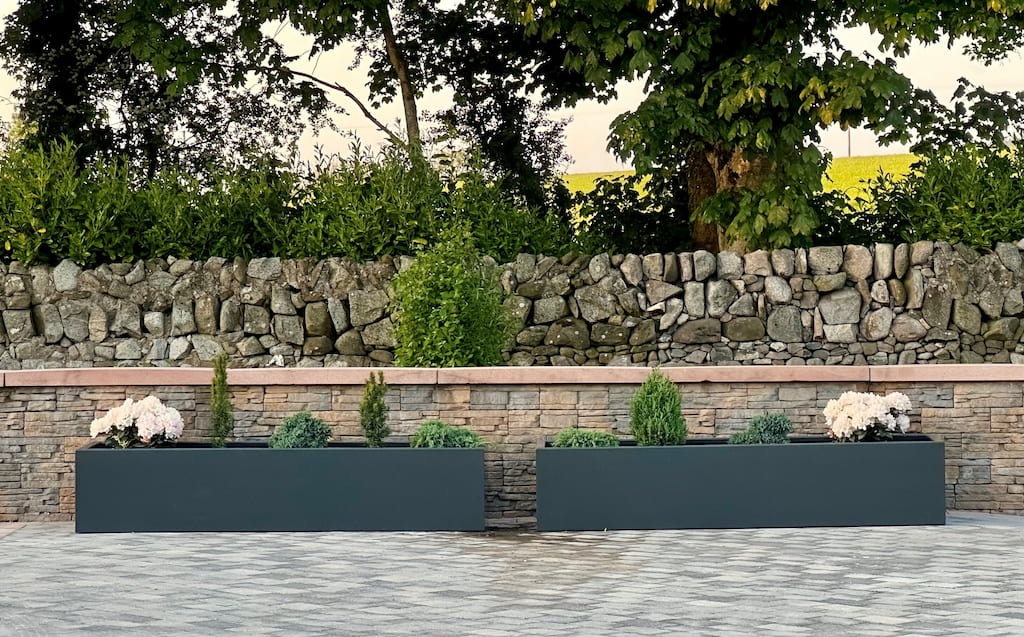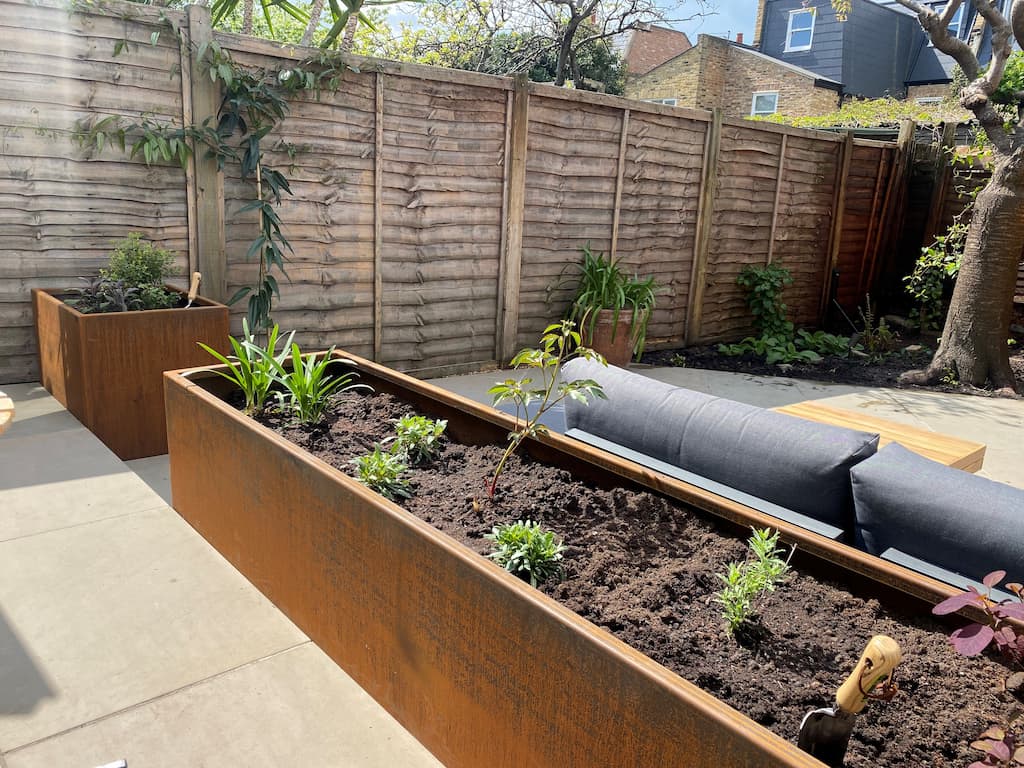How to Plant your Garden Container
How to Plant your Metal Garden Container
Container gardening offers a versatile approach to growing plants, making it perfect for situations where you need to move your plants regularly, face limitations due to soil or space, or deal with plants that spread excessively and need to be kept under control.
In this guide, we will walk you through the steps to successfully plant up your garden container, helping you create a vibrant and manageable garden.

Contents
Choosing the right planter
The first step associated with using metal planters in the garden is ensuring that you select the right type, which will depend upon several factors such as;
– the size of the plant growing in the container,
– whether the plants need to be protected in winter,
– and the level of drainage required for the plant.
For advice on planting up a bottomless planter please see our How to plant up your raised bed blog post.
The shape and size of containers
The size of the container should be sufficiently large enough to provide room for the plants within it to develop and grow. However, it is important to note that smaller containers will dry out more readily and therefore require additional water.
In terms of shape generally, containers with straight edges usually provide a more formality and structure to the garden whereas round planters will provide a more informal look in most cases. But greater formality can be created with these containers if they are used repeatedly within a garden. Examples of this include lining a walkway with trough planters at consistently repeating intervals.
Another key consideration associated with selecting a container is whether the planter has feet or not. Selecting containers with feet is advantageous in cases where the plant requires additional drainage as this makes it easier for the water to get out.
Positioning your planter
Having selected your container the next critical step is choosing an appropriate position to place the planter. The best positions for planters to be placed will depend greatly upon the plant that is selected. However, the 2 most critical factors are sunlight and the micro-climate surrounding the planter.
The amount of sunlight
By far and away the most important consideration is the amount of sunlight that the plants will receive. For the vast majority of plants that produce flowers, it is best to maximise the amount of sun that the plant receives as this will maximise the amount of photosynthesis that occurs and therefore the growth.
However, there are certain types of plants, that are generally grown for their foliage and leaves, which do better in shadier locations. In these cases, it is best to select areas that are protected from the afternoon sun.
The microclimate
In addition to the amount of sunlight that the plant receives, the other critical factor is the microclimate within a specific planting area. Microclimates are most commonly created by structures located in the planting area which can include buildings, fences, and even stones and rocks that are nearby.
Most of these types of structures will create a sheltered position that is generally slightly warmer than other locations in the garden; this is particularly the case when materials are made of brick or stone.
These types of objects have the capacity to absorb heat during the day and release it at night which can moderate the temperatures around the plants and thereby create more favourable conditions for growing plants.
Choosing the right time to plant
Once the container is in position the critical next step is choosing the right time to fill the container with plants. The timing of this particular process will depend greatly on the type of plants selected.
Bulbs
If you are planting spring flowering bulbs it is critical to plant them in autumn as they require a period of cold to successfully flower.
Deciduous Trees and Shrubs
Many of the trees and shrubs that are deciduous, which include Apples, Pears, Roses and Gooseberry to name a few plants, generally can be purchased and planted in late winter. This is the ideal time to plant these types of plants that are available as bare-rooted plants which can be purchased relatively cheaply.
Flowering Annuals and Vegetables
The vast majority of flowering annual plants available are best planted out in mid to late spring after the last frost. However, if you are planting into containers that are relatively small and can be moved easily, then planting can be done under cover a little earlier in spring.
Perennial Plants
Perennial plants for the most part can also be planted out in mid-spring when the weather is beginning to warm up. This is considered the ideal time for most plants because it provides an opportunity for the plants to establish their root system in the soil when the weather is relatively warm.
This increases the chances of the plants surviving both the hot summer and a very cold winter as a strong root system makes the plants less susceptible to unfavourable conditions.
For planting inspiration and ideas for your containers check out our top 10 ideas for planting in garden containers blog post.

Planting advice
When placing new plants into your planter for the first time the key considerations is the extent of drainage that is required and the quality of the growing medium, which will of course vary significantly depending on the type of plants.
Drainage
When growing plants in containers it is important to ensure that the plants have sufficient drainage. In cases where the container contains a base, it is important to have adequate drainage holes to allow water to flow out freely particularly in winter when there is significant amounts of rain as the roots of plants can rot.
To avoid these problems it is important to ensure that these drainage holes remain unblocked. A common way to do this is by carefully placing pieces of old broken pots or stones around the drainage holes to ensure that they do not get clogged with soil. In addition to this, it is also a good idea to fill the first two inches or so of the planter with a layer of gravel or drainage aggregate.
To separate the growing medium and drainage aggregate we recommend using a separation membrane, you can also use the membrane in the base of the planter to help filter the drainage water and keep any dirt inside the planter.
The Growing Medium
The ideal growing medium for growing plants will vary depending on the nature of the plants that you are growing, however, it is important that the medium has adequate nutrition to ensure that the plant can develop properly.
The extent of the nutrition required for the plants is, generally higher, in cases where the plant is producing fruit or flowers on a consistent basis.
To ensure that there is adequate nutrition we recommend using a peat-free potting mix in combination with compost as this will increase the level of nutrients present in the soil. It is also important to ensure that fertilizer is added on an annual basis to the container to replenish lost nutrients.
Watering
Plants growing in containers require more frequent watering than those in the ground, as they have limited access to natural moisture. The amount and frequency of watering depend on factors such as the plant type, container size, and soil quality.
During warm summers, container plants may need to be watered thoroughly on a daily basis as the soil in containers tends to dry out quickly due to higher temperatures and direct sunlight exposure.
Other considerations
Metal containers offer many advantages however one of the unique considerations associated with using metal is that it conducts heat and cold very effectively which can lead to the roots overheating or freezing in extreme conditions. Generally the smaller the container the more susceptible it is to extreme temperatures.
If you are concerned about excessive heat or cold you can use an insulating material on the inside of the planters to avoid direct contact between the soil and metal surface. During extreme weather conditions, smaller containers can be moved to shelter which can help to protect the plants.
Explore The Range
Discover the perfect addition to your garden with our extensive range of garden containers. We offer a wide variety of shapes and sizes, with options both with and without bases to suit your specific needs. Explore our metal planter collection today and find the ideal container to complement your outdoor space!
